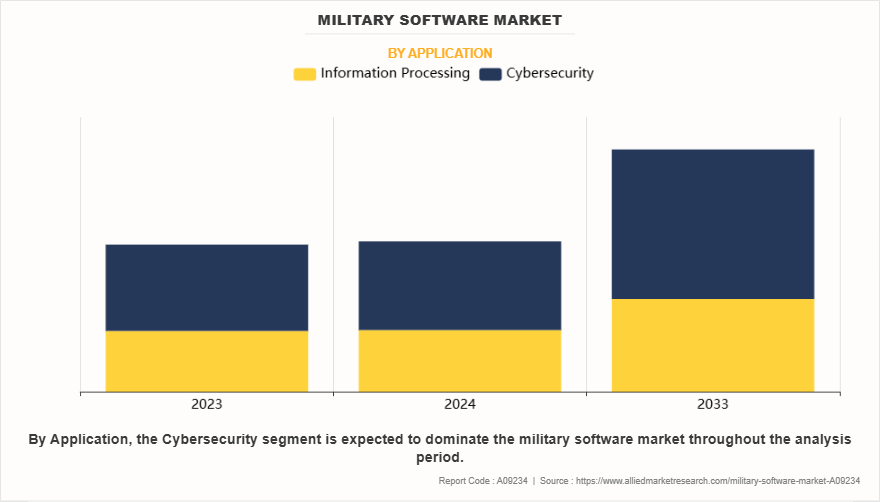Military Software Market Research, 2033
The global military software market was valued at $642.8 billion in 2023, and is projected to reach $1.1 trillion by 2033, growing at a CAGR of 5.5% from 2024 to 2033.

Report Key Highlighters
• The military software industry studies more than 16 countries. The analysis includes a country-by-country breakdown analysis in terms of value available from 2022 to 2032.
• The research combined high-quality data, professional opinion, and research, with significant independent opinion. The research methodology aims to provide a balanced view of the global market, and help stakeholders make educated decisions to achieve ambitious growth objectives.
• The research reviewed more than 3,700 product catalogs, annual reports, industry descriptions, and other comparable resources from leading industry players to gain a better understanding of the market.
• The military software market share is marginally fragmented, with players such as Aselsan A.S., Elbit Systems Ltd., General Dynamics Corporation, Honeywell International, Inc., BAE Systems, IBM Corporation, Rohde & Schwarz, RTX, Rolta India Limited, and Teledyne FLIR LLC. Major strategies such as contracts, partnerships, expansion, and other strategies of players operating in the market are tracked and monitored.
Market Definition and Introduction
Military software refers to specialized computer programs and systems developed and used by armed forces to support and enhance a wide range of defense-related operations. This software includes combat operations, intelligence gathering, surveillance, communications, logistics, cyber defense, training, and command and control systems. Rise in procurement of military communication solutions and rise in investment in modern warfare technologies are key factors driving the market growth. The growing emphasis on network-centric warfare, integration of artificial
intelligence (AI) and machine learning (ML) in defense systems, and need for secure and real-time data exchange across various military platforms are significantly contributing to the market growth. Furthermore, geopolitical tensions and cross-border conflicts are making governments upgrade their defense infrastructure, which in turn drives the demand for advanced military software solutions. Manufacturers are focusing on developing highperformance software to meet the evolving requirements of the next-generation military sector.
Rise in need for cybersecurity concerns
With growing dependence on digital networks and information technology in defense operations, the demand for robust cybersecurity solutions has become increasingly critical. Military software plays a central role in addressing this need, serving as a key enabler in protecting classified information, securing communication channels, and defending against evolving cyber threats. As modern military operations become more interconnected and datadriven, the risk of cyberattacks, data breaches, and electronic warfare continues to escalate. Rise in threats on the military battlefields is propelling defense agencies to prioritize cybersecurity integration within their software systems.
Advanced military software solutions are now developed with built-in encryption, intrusion detection, real-time threat monitoring, and automated response capabilities to counter sophisticated cyber adversaries. These features help in preventing unauthorized access and data manipulation as well as ensure operational continuity during highrisk scenarios. As a result, the rise in focus on cyber resilience is driving greater investment in next-generation military software platforms that can adapt to rapidly changing threat environments. Rise in need for enhanced security is one of the primary factors driving growth, as governments and defense organizations globally seek to modernize their digital infrastructure. Such factors are expected to drive the military software demand during the forecast.
Technical issues associated with military software
Effective data management is a critical method for military services, and the inability of military software to fulfill this role could severely constrain the industry. With steady increase in crime, particularly surge in cybercrime due to technological advancements, there is an urgent need for significant improvements in cybersecurity within the software industry. Neglecting to address these cybersecurity challenges could potentially impede the expansion of the market in the long term. Another factor that may act as a constraint on market growth is inadequate funding. Insufficient financial support may hamper the market growth of military software, limiting the industry's capacity to innovate and meet the evolving demands of modern military operations.
Increasing integration of aircraft accessory gearbox in airframe
Modern aircraft are incorporating lightweight, high-performance gearboxes that seamlessly integrate with airframe structures to optimize power transmission and enhance overall efficiency. This trend is particularly evident in nextgeneration commercial and military aircraft, where accessory gearboxes play a crucial role in powering hydraulic pumps, generators, and other essential systems. Also, as aircraft manufacturers focus on reducing weight and improving fuel efficiency, the demand for compact and advanced gearbox solutions is rising. The growing adoption of hybrid-electric propulsion systems and unmanned aerial vehicles (UAVs) further accelerates market expansion, creating significant opportunities for gearbox manufacturers to develop innovative, high-performance solutions that align with the evolving needs of the aerospace industry. Such factors will create lucrative growth opportunities for the aircraft accessory gearbox market growth.
Segment Review
The military software industry is segmented into aircraft type, component, application, end user, and region. By type, the market is divided into land and naval. On the basis of technology, the market is classified into learning intelligence, and advance computing. By application, the market is divided into information processing and cybersecurity. Region-wise, the military software market is analyzed across North America (U.S., Canada, and Mexico), Europe (UK, Germany, France, and rest of Europe), Asia-Pacific (China, India, Japan, South Korea, and rest of Asia-Pacific), and LAMEA (Latin America, the Middle East, and Africa).

By application, the military software market trends is categorized into information processing and cybersecurity. The cybersecurity segment dominated the military software market in 2023. Cybersecurity applications are integral to the military software market, serving to protect critical defense systems, networks, and data from an ever-evolving array of cyber threats. These applications include a range of technologies and solutions designed to safeguard military infrastructure and operations from unauthorized access, data breaches, espionage, and other malicious activities.

By type, the market is divided into land and naval. The land segment dominated the military software market growth in 2023. Land-based military software is a specialized digital system designed to enhance the effectiveness, coordination, and decision-making capabilities of ground forces. It operates by integrating a wide range of components, including command and control systems, sensors, navigation tools, communication networks, and vehicle or soldier-mounted equipment.

By technology, the military software market is categorized into learning intelligence and advance computing. The learning intelligence segment dominated the military software market in 2023. Learning intelligence technology, particularly artificial intelligence (AI) and machine learning (ML), plays a transformative role in the military software market by enabling systems to analyze vast amounts of data, adapt to changing scenarios, and support faster, more accurate decision-making.

Region-wise, the military software market is analyzed across North America (U.S., Canada, and Mexico), Europe (UK, Germany, France, and rest of Europe), Asia-Pacific (China, India, Japan, South Korea, and rest of Asia-Pacific), and LAMEA (Latin America, the Middle East, and Africa). North America accounted for the largest share in 2024.
Competitive Analysis
Competitive analysis and profiles of the major global military software market players that have been provided in the report include Aselsan A.S., Elbit Systems Ltd., General Dynamics Corporation, Honeywell International, Inc., BAE Systems, IBM Corporation, Rohde & Schwarz, RTX, Rolta India Limited, and Teledyne FLIR LLC. The key strategies adopted by the major players of the global military software market are product launch and mergers & acquisitions.
Top Impacting Factors
The military software market is expected to witness notable growth owing to rise in need for cybersecurity concerns, growing adoption of military software integration between control devices, sensors, and communication devices and increasing military expenditure and spending. Moreover, the development of military software for unmanned aerial systems (uas) and surge in demand for learning intelligence technology are expected to provide lucrative military software market opportunities during the forecast period. On the contrary, technical issues associated with military software limit the growth of the military software market demand.
Historical Data & Information
The global military software market is competitive, owing to the strong presence of existing vendors. Vendors in the global military software market with extensive technical and financial resources are expected to gain a competitive advantage over their competitors as they cater to market demands, which are higher than the supply. The competitive environment in this market is expected to increase owing to technological innovations, product extensions, and different strategies adopted by key vendors.
Key Developments/Strategies in Military Software Market
- In July 2023, Regal Rexnord Corporation invested $13.5 million to open state-of-the-art manufacturing plant, located in the Bafar industrial and technological park, Mexico. Through this expansion, it focusses on producing critical components for aerospace safety, including connection mechanisms for the aerospace industry and helicopter stabilizers.
- In July 2024, General Electric Company, through its subsidiary GE Aerospace, signed a contract to provide the Auxiliary Gearbox for Triumph Group, Inc. The gearbox is majorly used in F404 after burning turbofan engine with potential future use on multiple applications, including the T7-A, T-50, and TAI Hurjet platforms.
Key Benefits of Stakeholders
- This study comprises analytical depiction of the global military software market size along with the current trends and future estimations to depict imminent investment pockets.
- The overall global military software market analysis is determined to understand the profitable trends to gain a stronger foothold.
- The report presents information related to key drivers, restraints, and opportunities with a detailed impact analysis.
- The current global market forecast is quantitatively analyzed from 2022 to 2033 to benchmark the financial competency.
- Porter’s five forces analysis illustrates the potency of the buyers and suppliers in satellite services.
- The report includes the market share of key vendors and the global military software market forecast.
Military Software Market Report Highlights
| Aspects | Details |
| Market Size By 2033 | USD 1.1 trillion |
| Growth Rate | CAGR of 5.5% |
| Forecast period | 2023 - 2033 |
| Report Pages | 289 |
| By Application |
|
| By Type |
|
| By Technology |
|
| By Region |
|
| Key Market Players | IBM Corporation, Elbit Systems Ltd., Aselsan A.S., Rolta India Limited, BAE Systems, Teledyne FLIR LLC, Rohde & Schwarz, Honeywell International, Inc., General Dynamics Corporation, RTX |
The cybersecurity is the leading application of military software market.
The upcoming trends of military software market include rise in need for cybersecurity concerns and growing adoption of military software integration between control devices, sensors, and communication devices.
North America is the largest regional market for military software.
The global military software market was valued at $642.8 billion in 2023.
Aselsan A.S., Elbit Systems Ltd., General Dynamics Corporation, Honeywell International, Inc., are the top companies to hold the market share in Military Software.
Loading Table Of Content...
Loading Research Methodology...



